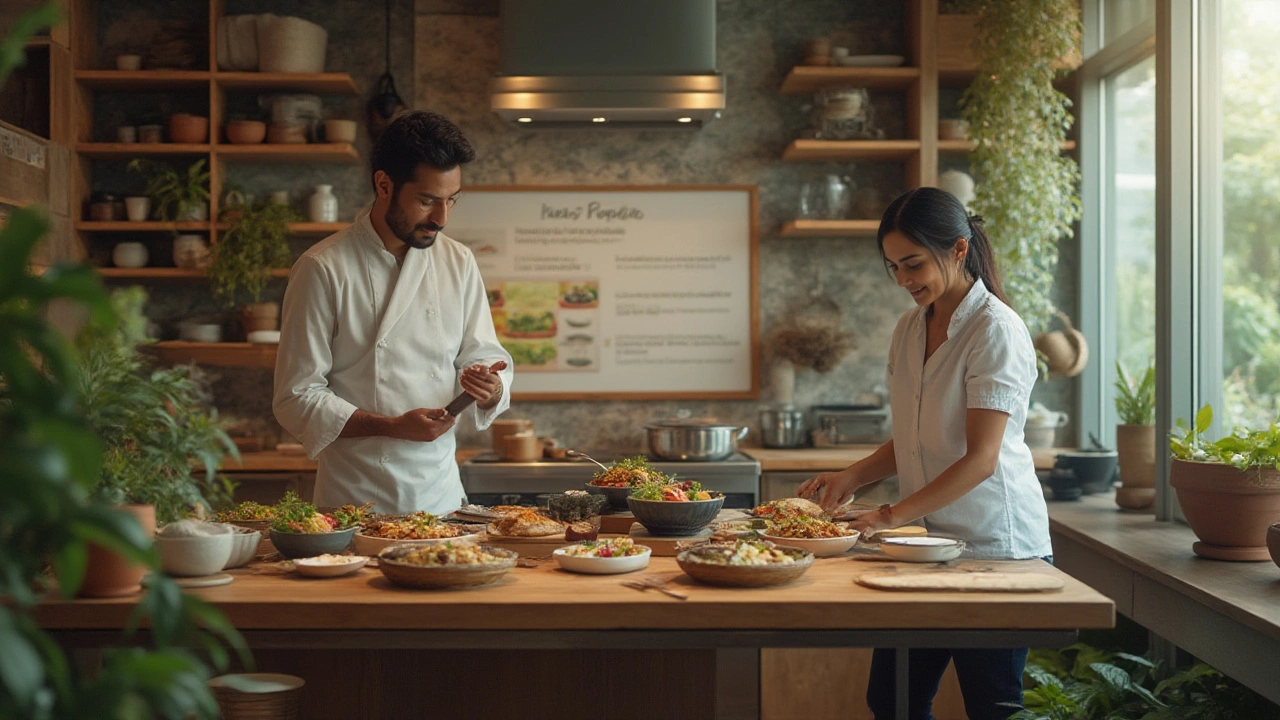Look around any Indian city, and you’ll spot one thing everywhere: people eating. Out on the streets, at fancy restaurants, inside food courts, and even on their phones ordering midnight biryani. Food is one of the wildest obsessions in India, and it doesn’t matter if you’re in Chennai or Chandigarh—it’s only getting bigger. But be warned: while the food industry is massive, not every food business is a goldmine. Some fizzle out as quickly as they start, others rake in profits that’ll make your accountant do a double take. So, which food business really makes the most money in India?
The Secret Sauce: What Defines Profitability in Indian Food Business?
Let’s get real for a moment. The term 'profitable' isn’t the same as 'popular' or 'famous.' Many restaurants have long waiting lines but a painful bank balance. Profitability in food is all about the gap between what you spend (raw material, labor, rent, packaging) and what you actually take home—your margin. Average restaurant profit margins in India hover around 10-15%. But some food businesses break out of that average, hitting 25% or more. How? They’re smart about costs, customer trends, and scalability.
Think cloud kitchens. These kitchens skip dine-in seating and focus on delivery, saving a bundle on rent and staff, and running on tech platforms like Swiggy or Zomato. Even during tough times, many cloud kitchens in Mumbai and Bangalore have kept their profits north of 20%, according to a 2024 report by the FSSAI. They can test menus quickly, ditch what doesn’t work, and keep overheads crazy low. But don’t write off classic food options just yet. Take chaats and street food. You'd be shocked how many family-run carts in Lucknow or Delhi can pocket more than major café chains, thanks to minimal costs and all-day crowds.
Now, let’s talk scale. Packaged snacks and sweets move faster than you might think. Companies selling namkeen, homemade pickles, or mithai have low spoilage, can ship across the country, and sell through both offline and online channels. For example, Haldiram’s posted revenues topping ₹5,400 crore in FY24, with a 22% jump from last year. Tech-based food delivery, modern cafés, and gourmet tiffin services are strong too, especially in metros with young working populations. Each of these models has its own quirks and risks, but the golden rule is: keep costs low, quality high, and never ignore what your customer wants next.
The Heavy Hitters: Top Profitable Food Businesses in India Right Now
If you ask folks who run food businesses what really works, you’ll get some surprises. Sure, opening a restaurant feels fancy, but in 2025, if you want to make money—real, spendable profit—these food businesses dominate.
- Cloud Kitchen Business: This is, by far, the fastest-growing and most profitable model. Set up a small commercial kitchen, sign up on food delivery apps, and experiment with multiple menu brands if you want. No decor, no big staff, no sky-high rent. Some owners run three or more virtual brands from the same kitchen. This model saw a whopping 35% growth between 2023-24, according to a RedSeer report.
- Quick Service Restaurants (QSR): Think burger, pizza, fried chicken, or momos take-away joints. They need fast service, low seating costs, and are designed for high footfall. Their average margins run 18-22%, and some QSR franchises are cheaper to start than a sit-down restaurant. Chains like Wow! Momo have crossed 850 stores in 2025, while McDonald's and Domino's keep adding dozens more every quarter.
- Packaged Snacks and Ready-to-Eat Food: Easy to ship, stable shelf life, and a pan-India market. Small businesses in Indore, Rajkot, and Kolkata have reached ₹1 crore yearly revenue in less than 3 years, selling namkeen, roasted seeds, and ready-to-eat curries on Amazon and Flipkart.
- Home Bakeries and Custom Cake Businesses: During the pandemic, and even today, home bakers in every large city have found a sweet spot: premium cakes, low investment, and decent pricing power. Smart social media marketing (hello, Instagram reels!), hyperlocal focus, and word-of-mouth bring repeat orders every week. Some solo bakers in Mumbai report profits crossing ₹1,00,000 per month from home.
- Street Food Stalls: It might surprise you, but street food vendors often have solid ROIs because of tiny overheads and daily cash flow. Think of idli-vada carts in Bengaluru or paani-puri stalls in Surat that can earn ₹5,000 a day for stalls open just five hours.
Here’s a quick snapshot of profits, startup costs, and margins from real-world Indian food businesses in 2025:
| Business Type | Profit Margin (%) | Monthly Profit (₹, average) | Initial Investment (₹) |
|---|---|---|---|
| Cloud Kitchen | 20-35 | 1,20,000 – 4,00,000 | 5,00,000 – 12,00,000 |
| QSR Franchise | 18-22 | 70,000 – 2,50,000 | 7,00,000 – 20,00,000 |
| Packaged Snacks | 25-30 | 50,000 – 2,00,000 | 3,00,000 – 8,00,000 |
| Home Bakery | 15-30 | 35,000 – 1,20,000 | 50,000 – 2,00,000 |
| Street Food Stall | 20-40 | 30,000 – 75,000 | 20,000 – 60,000 |

What Customers Want: Trends Shaping Food Business Profitability
People’s food habits are always changing. What worked five years ago might flop next season, but if you watch closely, you’ll see a few patterns always win big in 2025. The same folks who crave butter chicken one week might seek out vegan thalis the next. Customers are picky, restless, and obsessed with value plus taste.
The rise of health-conscious menus is huge now, especially in metros like Pune, Hyderabad, and Delhi. Low-cal rice bowls, keto parathas, vegan desserts—these are not niche anymore. A 2024 survey from the National Restaurant Association of India says that 43% of urban diners search for healthy options when ordering online. But it’s not just the big cities. Tier-II towns like Nagpur and Ranchi have doubled their orders for millets and organic snacks since last year.
Then there’s the convenience factor. Dine-in feels special, but delivery is non-negotiable. Fast, fresh, and affordable meal subscriptions—think office lunches or meal boxes—are everywhere now. I know people who run full-scale operations just prepping breakfast sandwiches and dal-chawal meals for office goers, racking up dozens of regular subscribers every month. The biggest brands use data like crazy, tracking which menu items sell when, which promotions work, and how fast their deliveries reach hungry customers.
Technology is the backbone here. If your menu looks dated or your online listing has bad photos, customers swipe right by. Even max, my dog, could tell you—first impressions matter. Quick payment options, live delivery tracking, tempting food photos, and quick replies to complaints keep people coming back. The businesses making serious money in 2025 know how to speak customer language—whether that’s quirky social media posts, quick WhatsApp support, or regular freebies for good reviews.
Pitfalls to Dodge: Challenges for Profitable Food Businesses
If the road to food riches were easy, everyone’s kitchen would be printing cash. But you’ll hit potholes along the way. For starters, food regulations have gotten stricter. Repeat mistakes with hygiene, FSSAI licensing, or allergies, and you could be shut down faster than it takes to fry a samosa. Always source from safe, reliable suppliers, and pay attention to your storage and labeling. Even the smallest slip-up can cause headaches, bad reviews, or legal trouble.
Then, there’s fierce competition. Every week I hear about someone’s cousin starting a burger joint or a college buddy launching a home bakery. It’s not enough to just make food that tastes good—you need a clear hook. Maybe it’s a new flavor, crazy-low prices, or super-fast delivery, but you can’t afford to blend into the crowd, especially if you’re in a crowded market.
Don’t forget about rising ingredient costs. With inflation, wars disrupting supply, and climate issues hitting crops, prices for oil, grains, and proteins can spike overnight—and your margins can shrink just as fast. Businesses that last always keep alternative vendors ready, bulk-buy when prices are down, and revisit their menu pricing regularly. I saw a local café update their menu prices five times last year alone. Smart, because squeezing pennies is the name of the game in this industry.
Another silent killer? Staff turnover. Good cooks, delivery guys, and cleaners often jump jobs for higher pay or better hours. Unlike what Instagram tells you, managing people is half the battle in the food business. Treat staff right, pay on time, and build a team that sticks around. That’s one of the big differences between low-earning shops and the ones who hit the profit jackpot year after year.

Tips to Get Started: How to Maximize Profits in an Indian Food Business
Start by picking a model proven to work. Don’t just follow trends—spot what your city or neighborhood actually needs. Is there a shortage of healthy breakfast options? Not enough night-time food deliveries? Find a gap and fill it, rather than copying what’s already everywhere. A little research goes a long way. I always chat with street vendors, office-goers, or even the occasional overenthusiastic foodie (looking at you, Cora) before making big decisions.
- Go lean at first. Limit your menu, test with a small audience, use rented kitchen spaces, or cloud kitchens. Don’t sink all your savings before knowing what clicks.
- Branding works wonders—your packaging, logo, and digital presence count more than you think. Quirky names, loyalty programs, referral discounts, and Insta-worthy photos aren’t just fluff—they’re free marketing.
- Keep expenses brutally low, especially in the beginning. Bulk-buy ingredients, negotiate with vendors, and look for reusable packaging. Even a tiny margin boost will stack up fast.
- Use every online platform you can—Swiggy, Zomato, Dunzo, Amazon, and even WhatsApp or Telegram groups. Don’t neglect direct ordering via your own app or website, either; you’ll save commission fees.
- Listen to your customers obsessively. Every suggestion, complaint, or positive review is a goldmine. Reward regulars, resolve any problem within hours, and you’ll win fans for life.
The food business is one wild ride. If you nail your costs, offer something people crave, and hustle with smart tech, you’ll outpace even bigger competitors. Your next big breakthrough could be as close as your own kitchen—or that food stall round the corner that never seems to shut down.

